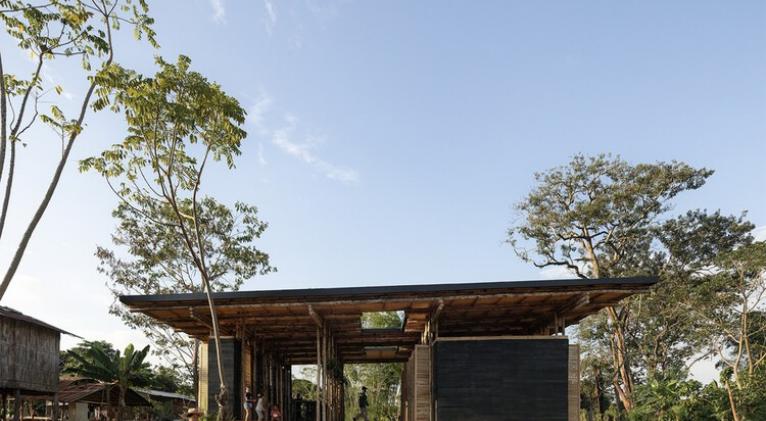From Extraction to Regeneration: How Architecture Can Drive Change in Rural Development Across Latin America
especiales

Rural areas have always played a fundamental role in the social and economic development of nations. Until the 18th century, they served as the primary setting for production and everyday life. However, with the Industrial Revolution came profound structural changes that redefined this dynamic. Industry began to occupy a central position, becoming closely tied to urban environments and giving rise to a dichotomous, hierarchical view of rural versus urban, agriculture versus industry. Within this framework, two opposing visions emerged. One predicted the disappearance of rural life in the face of urbanization and economic progress, while the other believed in its permanence and eventual revival. Today, it is clear which hypothesis has come to pass.
Rather than a simple revival, contemporary scholars advocate for the emergence of a “new rurality,” an approach that gained momentum particularly after the 2000s. Rural life began to assume a more prominent role in international agendas, tied to themes such as sustainability, resilience, and quality of life. From this debate, the need arises for new concepts and methodologies that not only abandon the notion of rural areas as secondary to urban life, but also empower and connect rural communities through ways of living that reflect their beliefs and values. It is precisely at this point that architecture takes on a central role.
It is estimated that about 20% of Latin America's population lives in rural areas, with countries like Bolivia, Ecuador, and Panama seeing rural populations account for nearly one-third of their total. In Brazil, the largest country in the region, approximately 25.6 million people live in rural areas. The country is said to be experiencing the third generation of public policies aimed at supporting family agriculture. This framework, which applies broadly to other Latin American nations as well, reflects the architectural challenges emerging in these settings. According to experts, the first generation of policies focused on agriculture and land reform, the second on social and welfare programs, and the third on developing new markets supported by food security and environmental sustainability.
These observations emphasize the importance of addressing the complex realities of rural areas, their people, and the natural environments to which they are deeply connected. In this uncertain path, a growing recognition is emerging: rural spaces carry significant weight in determining the planet's future. This extends beyond sustainability and environmental ties to the potential of rural areas as testing grounds for new ideas. As early as 2016, architect Rem Koolhaas warned of the urgency of turning attention back to the rural world and developing “methodologies for a landscape that, sooner or later, we will have to assume.” This notion of “assuming” refers not to imposing external transformations, but to guiding sustainable development from within, valuing local knowledge and, through it, empowering communities in authentic and self-directed ways.
In this historic shift from intense extraction to regeneration, architecture aligns with sustainability through a systemic perspective, integrating health and resilience across multiple scales. These shifts require tools that support the design and implementation of new flows and processes. One such tool is regenerative design, which seeks to restore local ecosystems in a healthy way, emphasizing active community participation. It promotes cultures capable of continuous learning and transformation in response to, and in anticipation of, inevitable changes.
In practice, several projects exemplify this approach. One is the Rural Campus of the University of the Environment in Acatitlán, Mexico. The project's goal is to initiate a local regeneration process, strengthening communities throughout the region. Designed specifically for the local context, the campus is self-sufficient in energy and water, supports on-site food production, and uses low-impact materials such as wood and earth to minimize its ecological footprint. Its significance, however, extends beyond design choices, recognizing its role as a knowledge hub within the rural setting. It contributes to a shift in paradigm and has been recognized by the Holcim Foundation.
Highlighting the importance of knowledge, and the projects that disseminate it, is essential when aiming to empower rural communities and support the rise of this new rurality. In this context, the First Productive Rural School in Tepetzintla, Mexico stands out. Built using locally sourced materials such as stone and bamboo, donated by families, the school offers educational spaces tailored to the region’s cultural, social, environmental, and economic context. Beyond the physical structure, the project demonstrates that mutual aid and collective work can achieve significant goals for autonomous and community-based rural development.
Another noteworthy example is the Center for Rural Development and Production "La Panificadora" in Babahoyo, Ecuador. This space was created to promote the local economy, strengthen traditional knowledge, and build educational networks. It focuses on energizing local value chains through bread-making, a staple in the Ecuadorian diet. The wooden modules are elevated above the ground, responding to the region’s frequent flooding. A central courtyard connects the modules with a bridge, in dialogue with traditional passive systems used along Ecuador’s coastal regions.
These projects, though modest in scale, serve as powerful examples of a complex rural renaissance. They embody regenerative design not merely as an effort to reduce impact, but as a profound commitment to the idea that architecture can, and should, act as a life-giving force—one that restores, renews, and revitalizes. This concept, inherent to nature, invites us to rethink the way we inhabit the world, encouraging a practice in which we give back far more than we take.














Add new comment